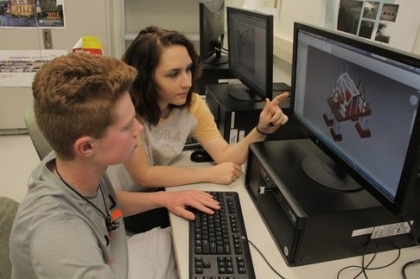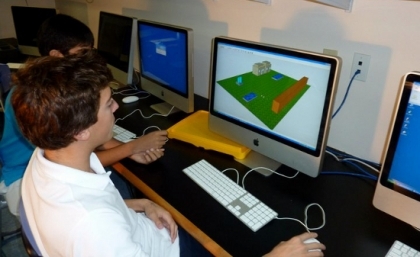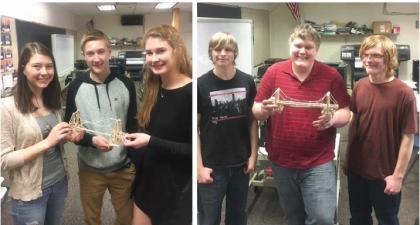Drafting/Design Technology (CAD)
Career Focus
Prepared for immediate employment, advanced certifications, and further education
Who Can Attend
This class is typically available to students in grades 9 -12.
Details
Students are prepared to enter college and the workforce as a skilled CAD technician. Students will graduate with advanced CAD skills by training on the most current CAD software. Students complete 2D and 3D projects with an emphasis on constructing what you design using advanced and specialized computer-aided drafting skills.
This class uses the most popular 3D CAD options, Autodesk’s AutoCad and Inventor, and Solidworks.
Resources
Photo Gallery
-
 Click to see a larger version
Skip to end of gallery
Skip to start of gallery
Click to see a larger version
Skip to end of gallery
Skip to start of gallery
-
 Click to see a larger version
Skip to end of gallery
Skip to start of gallery
Click to see a larger version
Skip to end of gallery
Skip to start of gallery
-
 Click to see a larger version
Skip to end of gallery
Skip to start of gallery
Click to see a larger version
Skip to end of gallery
Skip to start of gallery
-
 Click to see a larger version
Skip to end of gallery
Skip to start of gallery
Click to see a larger version
Skip to end of gallery
Skip to start of gallery
Career Ladder
Bachelor's Degree or Higher
- Architects, Except Landscape
- Architectural and Engineering Managers
- Career/Technical Education Teachers
- Commercial and Industrial Designers
- Engineers
- General and Operations Managers
- Industrial Production Managers
- Purchasing Managers
Associate's Degree, Long-Term Training & Apprenticeships
- Architectural and Civil Drafters
- Boilermakers
- Computer Numerically Controlled Machine Tool Programmers
- Drafters, All Other
- Mechanical Drafters
- Civil Engineering Technicians
- Industrial Engineering Technicians
- Jewelers and Precious Stone and Metal Workers
- Machinists
- Mechanical Engineering Technicians
- Millwrights
- Plumbers, Pipefitters, Steamfitters
- Power Plant Operators
- Sheet Metal Workers
- Structural Iron and Steel Workers
- Tool and Die Makers
- Water and Wastewater Treatment Plant and System Operators
- Wind Turbine Service Technicians
Certificate or Moderate-Term Training
- Chemical Equipment Operators
- Computer-Controlled Machine Tool Operators
- Furnace, Kiln, Oven, Drier, and Kettle Operators
- Inspectors, Testers, Sorters, Samplers, and Weighers
- Installation, Maintenance, and Repair Workers
- Machine Setters
- Maintenance Workers, Machinery
- Mechanical Door Repairers
- Medical Equipment Repairers
- Structural Metal Fabricators and Fitters
- Tool Grinders, Filers, and Sharpeners
- Welders, Cutters, Solderers, and Brazers
High School Diploma or Equivalent & Short-Term Training
- Cutting and Slicing Machine Setters, Operators
- Helpers--Installation, Maintenance, and Repair Workers
- Helpers--Pipelayers, Plumbers, Pipefitters, and Steamfitters
- Helpers--Production Workers
- Sawing Machine Setters, Operators
- Supervisors of Mechanics, Installers and Repairers
- Supervisors of Production and Operating Workers
- Woodworking Machine Setters, Operators
High School Credit
Students should inquire within their guidance office about high school curriculum requirements that may be satisfied through a CTE class, as this is determined individually by school district.
College Credit
College credit(s) possible
- Students can earn up to 4 college credits from NMU
- Students must earn a grade of 90% or better and be recommended by the instructor
- Each college reserves the right to set its own credit-granting policy
- Contact your college(s) to find out the score it requires to grant credit, the number of credit hours granted, and the course(s) that can be bypassed with a satisfactory score
NMU course satisfied
- DD 100 - Technical Drafting/Intro to CADD - NMU Credits Granted 4
National College Credit Recommendation (Test required)
- Students have the potential of earning college credits by scoring 70% or better on the National Occupational Competency Testing Institute (NOCTI) assessment for Architectural Drafting
- Test is administered in the classroom during mid-spring semester
- Over 1,500 colleges and universities accept NOCTI credit recommendations
Industry Certification
Industry-recognized Certification
- 10-hour OSHA General Industry Safety Certificate*
*Credentials are nationally recognized, portable and stackable, which means students have the option of attaining more advanced credentials in the future.
Success Story
Negaunee HS CAD Bridge Building Dynasty!
Back to back to back to back to back............ national titles in model bridge building!
 Kevin Bell and three seniors from his Negaunee High School Computer-Aided Design (CAD) class will compete for the Upper Peninsula school’s 10th straight contest that tests students’ design, engineering, and construction skills.
Kevin Bell and three seniors from his Negaunee High School Computer-Aided Design (CAD) class will compete for the Upper Peninsula school’s 10th straight contest that tests students’ design, engineering, and construction skills.
The highly competitive TRAC Bridge Challenge now accepts six entries from more than 250 junior and senior teams vying to compete from across the country, so even being accepted into the competition is tough. In previous years, only three teams were selected to compete.
In 2011, Bell’s three teams represented the entire national competition.
Students apply for entry by writing a proposal and submitting drawings and photos of their design process and bridge. Those who are accepted to compete must deliver a PowerPoint presentation and watch their model go through strength testing.
Students spend months researching, designing, constructing and testing model bridges made of balsa wood, glue, and string that can bear weight. Bell’s winning team last year built a bridge that weighed 26 grams and held 254 pounds. The key is scoring a high strength-to-weight ratio.
“This is the best cross-curricular project you could ask for,” Bell said. “They’re using math skills; they’re using writing skills; they’re using CAD skills; and in some ways they’re using business skills.”
Bell’s students have competed for years in competitions at both the state and national level. This year both of his three-person teams qualified for the state competition, administered by the Michigan Department of Transportation and judged by working engineers from MDOT.
And Bell recently learned one of his teams will be headed to Tennessee for this year’s national challenge run by the American Association of State Highway and Transportation Officials. The challenge in both competitions this year was to construct a self-anchored suspension bridge.
The teams have spent a lot of time doing compression and torsion testing of their materials and different kinds of joints. There is trial-and-error, redesigning, and revising to be done. The end product combines students’ knowledge and research with their unique style, Bell said.
He has built a unique four-year CAD program that attracts both college-bound students interested in mechanical, architectural, and civil engineering and those interested in a skilled trades career after high school. Bell also teaches welding and wood-working at the school.
A feeder program at the middle school—taught by Bell’s brother—introduces students to design concepts using pencil and paper on drafting boards. When they move through Bell’s program throughout their high school careers, students use the same software as professionals in the field.
The reasons for the program’s huge success are many, Bell said. Not many school districts are committed to fund a CAD program that students can follow from middle school through all four years of high school.
The program starts with the basics on pencil and paper to build students’ foundational understanding, before transitioning in second semester of freshman year to using the technical equipment that Bell has acquired: computers, software, 3-D printers.
Of course, the students themselves are a key ingredient, he says. They look forward to the bridge building competitions for three years. “It’s a full year of work, and I only have them for an hour a day which goes by pretty quick. They do a lot of work at home.”
Nearly all of his students go on to some kind of career in engineering or a skilled trade in industry, he said.
“They’re kids who are highly motivated, just a great group. They want to excel, so that helps a lot, too.”
Both of Bell’s teams will attend the MDOT Michigan Design and Build Bridge Challenge. In addition, the team known as Bridge Builders of Negaunee, will go to the AASHTO TRAC Bridge Challenge in Tennessee.
Locations
- Gwinn High School
- Munising High School
- Negaunee High School
